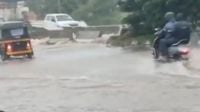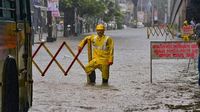In a summer marked by devastation and heartbreak, the mountains of South Asia have once again borne the brunt of nature’s fury. Flash floods and landslides, triggered by relentless monsoon rains and catastrophic cloudbursts, have left hundreds dead, thousands displaced, and entire communities grappling with loss from Pakistan’s Khyber Pakhtunkhwa to the Himalayan valleys of northern India. The scale and suddenness of the disasters, experts warn, are no longer rare anomalies—they are the new normal in a region where climate change and unchecked development have created a perilous mix.
In northwestern Pakistan, the death toll from flash floods and landslides surpassed 350 by mid-August 2025, according to local authorities cited by The News International. The district of Buner in Khyber Pakhtunkhwa was hit hardest, accounting for over 200 fatalities after what survivors described as torrents that “came like fire.” Gul Zarin, a shopkeeper who lost his brother, recalled, “It felt as if the sky broke apart. We had no chance to run.” The tragedy unfolded with little warning, as a wall of mud and boulders crashed down the mountains, flattening homes and sweeping away lives in seconds.
The devastation did not end there. Neighboring districts—Swat, Bajaur, Dir, Shangla, Mansehra, and Kohistan—were similarly ravaged as swollen rivers swept away bridges, homes, and even police outposts. Dozens remained missing, and the true toll may never be fully known. Relief operations have been hampered by broken roads and washed-away bridges, leaving many survivors to fend for themselves. In Shangla, villagers dug through the earth with bare hands to recover their dead. “We buried them ourselves. There was no one else to help,” said a teenage boy, his face streaked with dust and grief.
Even those tasked with rescue were not spared. On August 16, a government helicopter ferrying relief supplies to Bajaur crashed in heavy rain, killing all five on board, including two pilots. One pilot had messaged his wife earlier that day, promising, “Don’t worry, I’ll be back tonight.” The crash underscored the dangers faced by first responders and the overwhelming challenges of delivering aid amid ongoing downpours.
Meanwhile, the threat of further flooding loomed large. The Pakistan Meteorological Department warned of more rain until August 21, with risks of cloudbursts and glacial lake outbursts persisting. Rising waters in Swabi and Mardan districts threatened to spill into the Indus plains, prompting farmers to move cattle and bedding to higher ground. “We can see the river swelling every hour. If it breaks, we will lose everything,” said one anxious farmer, his eyes fixed on the churning waters.
Across the border, northern India was reeling from its own disaster. On August 5, a cloudburst in the upper catchment of the Kheer Ganga river unleashed a torrent of water and debris into Dharali village in Uttarkashi, sweeping away homes, hotels, and shops. At least four people were killed and nearly a hundred reported missing, as reported by ETV Bharat. Roads connecting the Harsil Valley collapsed, stranding entire communities and stalling rescue efforts. The scenes echoed earlier tragedies, including the 2013 Kedarnath floods that killed more than 6,000 people and the 2021 Chamoli glacier disaster that claimed over 200 lives.
What makes these disasters particularly harrowing is their growing frequency and intensity. According to a Nature Communications study, India has witnessed a threefold increase in extreme rainfall events between 1901 and 2015, with Uttarakhand among the hardest hit. The Himalayas, warming at twice the global average, are experiencing accelerated glacial melt and destabilized slopes. As BBC notes, the combination of moisture-laden monsoon winds, mountainous terrain, and rising temperatures creates ideal conditions for cloudbursts—sudden, violent downpours that can dump over 100 millimeters of rain in less than an hour over a small area. These “rain bombs” trigger flash floods, landslides, and mudflows, overwhelming even the most prepared communities.
Climate change has supercharged the hydrologic cycle, making rare events more frequent and frequent events more destructive. “Rising global temperatures have supercharged the hydrologic cycle, leading to more intense and erratic rainfall,” explained Khalid Khan, a former special secretary for climate change in Pakistan, in comments relayed by BBC. “In our northern regions, warming accelerates glacier melt, adds excessive moisture to the atmosphere, and destabilises mountain slopes.”
Yet, while nature’s role is undeniable, human choices have made matters worse. In Uttarkashi, the Bhagirathi Eco-Sensitive Zone was established in 2012 to protect fragile ecosystems, mandating strict restrictions on heavy construction and activities that alter natural drainage. In practice, however, regulations have been widely flouted. Multi-storey hotels and restaurants crowd riverbanks, roads are cut through unstable slopes, and hydropower projects proceed despite repeated expert warnings. The Dharali flood exposed how commercial interests and short-term gains can override ecological safety, turning extreme weather into catastrophe.
Pakistan faces similar challenges. The 2022 floods, which killed over 1,700 people and submerged a third of the country, are still fresh in collective memory. This year’s devastation has been even swifter and more violent, and scientists warn that each monsoon season brings greater risks as the atmosphere warms. The economic costs are staggering: climate-related disasters already cost India an estimated $87 billion annually, according to the World Bank, and the figure is expected to rise sharply unless development policies change course.
Despite the mounting toll, both countries struggle to move from reactive disaster management to proactive risk reduction. Early warning systems exist, but, as Pakistani official Asfandyar Khan Khattak told BBC, “there was no forecasting system anywhere in the world” that could pinpoint the exact time and location of a cloudburst. In Buner, the downpour struck so suddenly that residents had no time to react, despite the presence of an early warning system. Community organizations like SOST advise practical precautions: avoid building homes near rivers and valleys, postpone travel during heavy rain, keep emergency kits ready, and invest in afforestation and improved drainage to reduce runoff.
Experts urge a fundamental shift. Regulations in eco-sensitive zones must be strictly enforced, with independent monitoring to keep floodplains and unstable slopes free of permanent structures. Every major infrastructure project should undergo rigorous climate and geohazard audits, and meteorological radar coverage must be expanded to provide real-time warnings. Community resilience should be prioritized, with relocation and livelihood support for those in high-risk zones, and the private sector must step up investment in climate-resilient infrastructure and sustainable tourism.
The stories from Pakistan and India are not just tales of loss—they are warnings. As one resident of Dir put it, “Maybe people across the border heard this thunder too. It was the sound of our lives breaking.” The monsoon no longer brings life alone; it brings a reckoning that respects no borders. Unless policymakers act decisively to embed climate resilience into every aspect of mountain development, the tragedies of 2025 will not be the last.






